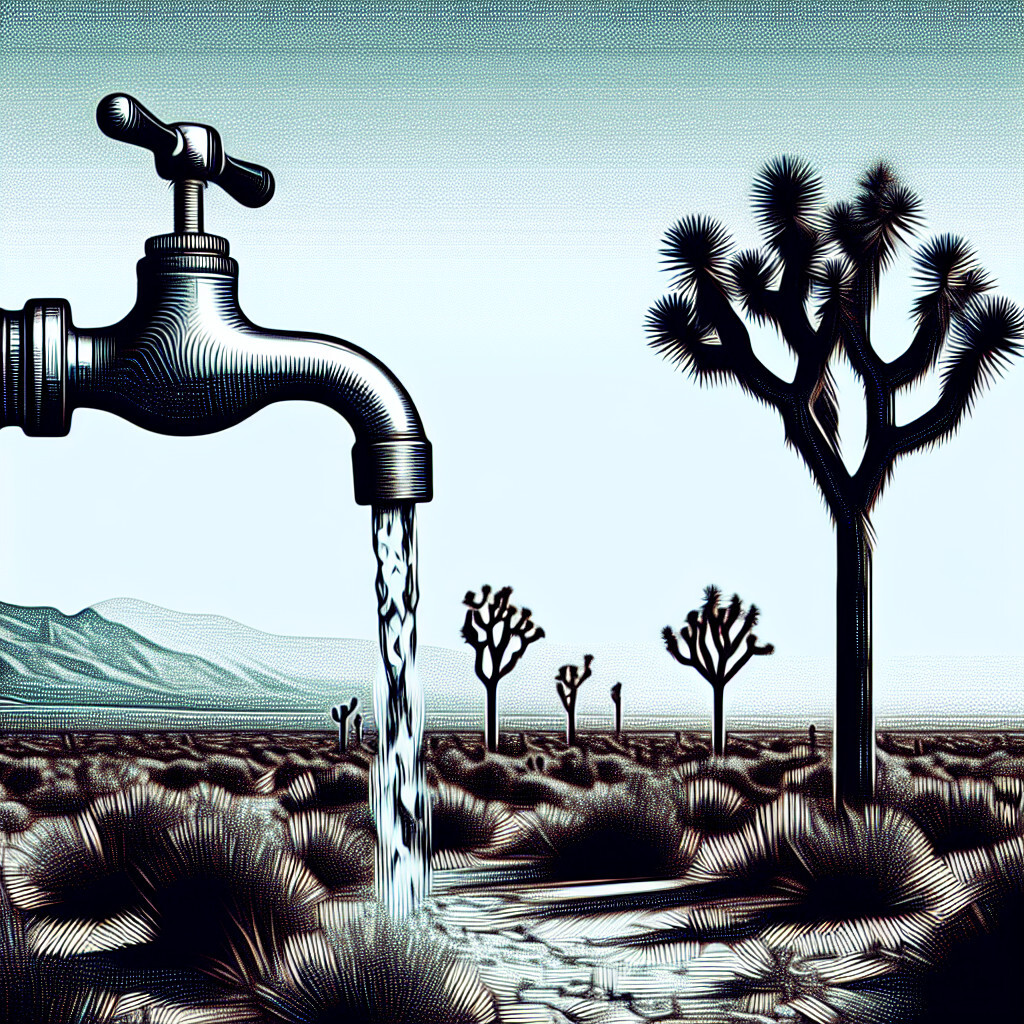-
Table of Contents
“Joshua Tree Tap Water: Pure, Natural, Refreshing.”
Introduction

Joshua Tree tap water is a crucial resource in the Joshua Tree National Park, located in southeastern California. This water is sourced from the underground aquifers and is treated to meet the drinking water standards. However, due to the arid climate and limited rainfall, the region often faces water scarcity. The quality and availability of tap water in Joshua Tree is a significant concern for both residents and the millions of tourists who visit the national park each year.
Understanding the Water Crisis in Joshua Tree
Joshua Tree, a small desert town in California, is renowned for its stunning national park, which attracts millions of visitors each year. However, beneath the surface of this natural beauty lies a pressing issue that is often overlooked: the water crisis. The town’s water supply, primarily sourced from the local groundwater, is under severe strain due to a combination of factors, including climate change, over-extraction, and pollution.
The primary source of water in Joshua Tree is the underground aquifer, a natural reservoir that collects and stores water over time. However, the rate at which water is being extracted from this aquifer far exceeds the rate at which it is being replenished. This over-extraction is largely due to the increasing population and the influx of tourists, both of which have led to a surge in water demand.
Climate change further exacerbates this issue. The region is experiencing longer and more severe droughts, reducing the amount of rainfall that can replenish the aquifer. Additionally, higher temperatures increase evaporation rates, further depleting the water supply. This combination of over-extraction and climate change has led to a significant drop in the water table, making it increasingly difficult and expensive to access water.
The quality of tap water in Joshua Tree is another major concern. The groundwater is naturally high in minerals such as calcium and magnesium, making it hard water. While hard water is not harmful to health, it can cause issues with plumbing and appliances. More worryingly, the groundwater has been found to contain elevated levels of arsenic, a toxic element that can cause serious health problems if consumed in large amounts over time.
The contamination is believed to be the result of both natural processes and human activities. Arsenic is naturally present in the earth’s crust and can leach into groundwater over time. However, human activities such as mining and agriculture can also contribute to arsenic contamination. In Joshua Tree, the legacy of gold mining in the area has been linked to the high arsenic levels in the water.
Addressing the water crisis in Joshua Tree requires a multi-faceted approach. Conservation efforts are crucial to reduce water consumption and slow the depletion of the aquifer. This includes implementing water-saving measures such as low-flow fixtures and efficient irrigation systems, as well as promoting water conservation awareness among residents and visitors.
Improving the water quality is equally important. This can be achieved through regular testing and monitoring of the water supply, as well as implementing treatment methods to remove contaminants. In the case of arsenic, various treatment options are available, including coagulation-filtration, adsorption, and reverse osmosis.
In conclusion, the water crisis in Joshua Tree is a complex issue that requires urgent attention. While the town’s natural beauty continues to draw visitors from around the world, it is crucial to remember that this beauty relies on a delicate balance of natural resources, including water. By understanding the challenges and working towards sustainable solutions, we can help ensure that Joshua Tree remains a vibrant and thriving community for generations to come.
The Impact of Tap Water Quality on Joshua Tree Residents
The quality of tap water is a critical issue that affects the health and well-being of residents in any community. In Joshua Tree, a small town located in the Mojave Desert of Southern California, this issue is particularly significant due to the unique environmental conditions of the region. The quality of tap water in Joshua Tree has a profound impact on the residents, influencing not only their health but also their lifestyle and economic conditions.
Joshua Tree’s tap water is sourced from the Mojave Desert’s underground aquifers. These aquifers are replenished by rainfall, which is scarce in this arid region. Consequently, the water supply is limited, and the quality of the water is affected by the natural minerals found in the desert soil. High levels of minerals such as calcium and magnesium make the water hard, which can lead to various health and household issues.
The hardness of Joshua Tree’s tap water can have several health implications. While hard water is not generally considered harmful to health, some studies suggest that it can contribute to certain health problems. For instance, the high mineral content can lead to skin irritation and dryness. Moreover, consuming hard water over a long period may increase the risk of developing kidney stones. Therefore, the quality of tap water in Joshua Tree can directly impact the health of its residents.
In addition to health concerns, the hard water in Joshua Tree also affects the daily lives of its residents. Hard water can cause scale buildup in pipes and appliances, leading to decreased efficiency and increased maintenance costs. It can also make cleaning more difficult, as soap does not lather well in hard water. These issues can significantly affect the quality of life for Joshua Tree residents, adding unnecessary stress and financial burden.
The economic implications of the tap water quality in Joshua Tree are also noteworthy. The cost of treating hard water can be substantial for both individual households and the community as a whole. Many residents opt for water softening systems to mitigate the effects of hard water. However, these systems can be expensive to install and maintain. On a larger scale, the local government may need to invest in infrastructure to treat the water supply, which can strain the community’s budget.
Furthermore, the quality of tap water can influence the attractiveness of Joshua Tree as a place to live or visit. The town is known for its stunning desert landscapes and is a popular destination for tourists and outdoor enthusiasts. However, concerns about tap water quality could deter potential residents and visitors, impacting the local economy.
In conclusion, the quality of tap water in Joshua Tree has a significant impact on the health, lifestyle, and economic conditions of its residents. It is a complex issue that requires careful consideration and action from both individuals and the community as a whole. By addressing this issue, Joshua Tree can ensure the well-being of its residents and continue to thrive as a unique and vibrant desert community.
Exploring Solutions for Joshua Tree’s Tap Water Issues
Joshua Tree, a small community located in the heart of the Mojave Desert, is renowned for its stunning landscapes and unique biodiversity. However, beneath the surface of this natural beauty lies a pressing issue that has been plaguing the residents for years – the quality of tap water. The tap water in Joshua Tree has been a subject of concern due to its high levels of arsenic and fluoride, which exceed the maximum contaminant levels set by the Environmental Protection Agency (EPA). This situation has led to a pressing need for effective solutions to address the tap water issues in Joshua Tree.
The primary source of tap water in Joshua Tree is groundwater, which is naturally high in minerals. While some minerals are beneficial for health, others like arsenic and fluoride can pose serious health risks when consumed in excess. Arsenic, a potent carcinogen, can lead to various forms of cancer, while excessive fluoride can cause dental and skeletal fluorosis. The presence of these contaminants in the tap water has made it unsafe for consumption, forcing residents to rely on bottled water.
Addressing the tap water issues in Joshua Tree requires a multi-faceted approach. One potential solution is the installation of advanced water treatment systems. These systems can effectively remove harmful contaminants from the water, making it safe for consumption. However, the high cost of these systems can be a barrier for many residents. Therefore, it is crucial to explore funding options, such as grants and subsidies, to make these systems more accessible.
Another potential solution is the implementation of strict water quality monitoring and regulation. Regular testing of the tap water can help identify any changes in the levels of contaminants, allowing for timely intervention. Moreover, enforcing stringent water quality standards can ensure that the water supplied to the residents meets the safety guidelines set by the EPA.
Public education is also a key component in addressing the tap water issues in Joshua Tree. Many residents may not be aware of the risks associated with consuming contaminated water. Therefore, conducting awareness campaigns can help inform the residents about the importance of safe drinking water and the steps they can take to ensure their water is safe for consumption.
In addition to these solutions, there is also a need for research to explore alternative water sources. Given the arid climate of Joshua Tree, rainwater harvesting could be a viable option. This method involves collecting and storing rainwater for later use, reducing the reliance on groundwater. However, this method requires careful planning and implementation to ensure the collected water is safe for consumption.
In conclusion, addressing the tap water issues in Joshua Tree is a complex task that requires concerted efforts from various stakeholders, including the local government, water suppliers, and the residents themselves. By implementing advanced water treatment systems, enforcing strict water quality standards, educating the public, and exploring alternative water sources, it is possible to ensure that the residents of Joshua Tree have access to safe and clean tap water. While these solutions may not completely eliminate the problem, they can significantly reduce the risks associated with consuming contaminated water, thereby improving the overall health and well-being of the community.
The Role of Conservation in Preserving Joshua Tree’s Water Supply
Joshua Tree, a renowned national park located in southeastern California, is a unique desert ecosystem that is home to a variety of plant and animal species. The park’s namesake, the Joshua Tree, is a distinctive and resilient species that has adapted to thrive in the harsh desert environment. However, the survival of these trees and the overall health of the park’s ecosystem are heavily dependent on a precious and increasingly scarce resource: water.
Water scarcity is a pressing issue in Joshua Tree, primarily due to the region’s arid climate and the increasing demands of a growing population and tourism industry. The park’s water supply primarily comes from underground aquifers, which are replenished by infrequent and often unpredictable rainfall. As such, the conservation of this vital resource is of paramount importance.
The role of conservation in preserving Joshua Tree’s water supply cannot be overstated. Conservation efforts are multifaceted and involve a combination of strategies aimed at reducing water consumption, protecting water quality, and ensuring the sustainable management of water resources.
One of the key strategies in water conservation is the promotion of water-efficient practices among residents and visitors. This includes encouraging the use of water-saving appliances and fixtures, promoting water-wise landscaping, and educating the public about the importance of water conservation. By reducing individual water use, the pressure on the park’s water resources can be significantly alleviated.
In addition to reducing water consumption, conservation efforts also focus on protecting water quality. This is particularly important in Joshua Tree, where the park’s water supply is vulnerable to contamination from various sources, including runoff from roads and developed areas, waste from campgrounds, and pollutants from agricultural activities in the surrounding areas. To protect water quality, measures such as regular monitoring of water sources, strict enforcement of waste disposal regulations, and the implementation of best management practices in agriculture are essential.
Furthermore, the sustainable management of water resources is a critical aspect of conservation. This involves careful planning and management of water use to ensure that the needs of both the park’s ecosystem and human users are met without depleting the water supply. For instance, the park’s management has implemented measures such as limiting the number of visitors during peak periods and restricting certain water-intensive activities to help preserve the water supply.
The conservation of Joshua Tree’s water supply is not just about ensuring the survival of the park’s unique flora and fauna. It is also about preserving the natural beauty and ecological integrity of the park for future generations to enjoy. Moreover, it is about recognizing our responsibility as stewards of the environment and taking concrete steps to reduce our impact on this precious resource.
In conclusion, the role of conservation in preserving Joshua Tree’s water supply is crucial. Through a combination of water-efficient practices, protection of water quality, and sustainable management of water resources, we can help ensure the survival of the park’s unique ecosystem and preserve its natural beauty for generations to come. However, the success of these efforts ultimately depends on the collective action and commitment of all stakeholders, including park management, local residents, visitors, and the wider community.
Q&A
1. Question: Is tap water safe to drink in Joshua Tree?
Answer: The tap water in Joshua Tree is generally safe to drink, but it has a high mineral content that some people may find unpalatable.
2. Question: Where does Joshua Tree’s tap water come from?
Answer: Joshua Tree’s tap water comes from underground wells that tap into the aquifer beneath the Mojave Desert.
3. Question: Can I use tap water for cooking in Joshua Tree?
Answer: Yes, you can use tap water for cooking in Joshua Tree. However, due to its high mineral content, it may alter the taste of some foods.
4. Question: Is the tap water in Joshua Tree hard or soft?
Answer: The tap water in Joshua Tree is considered hard due to its high mineral content.
Conclusion
In conclusion, tap water in Joshua Tree may not be safe to drink due to the high levels of arsenic and other contaminants. It is recommended to use filtered or bottled water for drinking and cooking purposes.






